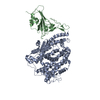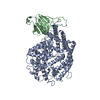+Search query
-Structure paper
| Title | Structural basis of increased binding affinities of spikes from SARS-CoV-2 Omicron variants to rabbit and hare ACE2s reveals the expanding host tendency. |
|---|---|
| Journal, issue, pages | mBio, Vol. 15, Issue 2, Page e0298823, Year 2024 |
| Publish date | Feb 14, 2024 |
 Authors Authors | Kaiyuan Shi / Linjie Li / Chunliang Luo / Zepeng Xu / Baihan Huang / Sufang Ma / Kefang Liu / Guanghui Yu / George F Gao /  |
| PubMed Abstract | The potential host range of severe acute respiratory syndrome coronavirus 2 (SARS-CoV-2) has been expanding alongside its evolution during the pandemic, with rabbits and hares being considered ...The potential host range of severe acute respiratory syndrome coronavirus 2 (SARS-CoV-2) has been expanding alongside its evolution during the pandemic, with rabbits and hares being considered important potential hosts, supported by a report of rabbit sero-prevalence in nature. We measured the binding affinities of rabbit and hare angiotensin-converting enzyme 2 (ACE2) with receptor-binding domains (RBDs) from SARS-CoV, SARS-CoV-2, and its variants and found that rabbit and hare ACE2s had broad variant tropism, with significantly enhanced affinities to Omicron BA.4/5 and its subsequent-emerged sub-variants (>10 fold). The structures of rabbit ACE2 complexed with either SARS-CoV-2 prototype (PT) or Omicron BA.4/5 spike (S) proteins were determined, thereby unveiling the importance of rabbit ACE2 Q34 in RBD-interaction and elucidating the molecular basis of the enhanced binding with Omicron BA.4/5 RBD. These results address the highly enhanced risk of rabbits infecting SARS-CoV-2 Omicron sub-variants and the importance of constant surveillance.IMPORTANCEThe severe acute respiratory syndrome coronavirus 2 (SARS-CoV-2) pandemic has swept the globe and caused immense health and economic damage. SARS-CoV-2 has demonstrated a broad host range, indicating a high risk of interspecies transmission and adaptive mutation. Therefore, constant monitoring for potential hosts is of immense importance. In this study, we found that Omicron BA.4/5 and subsequent-emerged sub-variants exhibited enhanced binding to both rabbit and hare angiotensin-converting enzyme 2 (ACE2), and we elucidated the structural mechanism of their recognition. From the structure, we found that Q34, a unique residue of rabbit ACE2 compared to other ACE2 orthologs, plays an important role in ACE2 recognition. These results address the probability of rabbits/hares being potential hosts of SARS-CoV-2 and broaden our knowledge regarding the molecular mechanism of SARS-CoV-2 interspecies transmission. |
 External links External links |  mBio / mBio /  PubMed:38112468 / PubMed:38112468 /  PubMed Central PubMed Central |
| Methods | EM (single particle) |
| Resolution | 2.75 - 7.08 Å |
| Structure data | EMDB-37701, PDB-8wox: EMDB-37702, PDB-8woy: EMDB-37703, PDB-8woz:  EMDB-37704: Cryo-EM map of SARS-CoV-2 prototype spike protein in complex with rabbit ACE2  EMDB-37706: Cryo-EM map of SARS-CoV-2 Omicron BA.4/5 spike protein in complex with rabbit ACE2  EMDB-38137: Cryo-EM map of SARS-CoV spike protein(6P) in complex with rabbit ACE2, 1-up state  EMDB-38144: Cryo-EM map of SARS-CoV spike protein(6P) in complex with rabbit ACE2, 2 RBD-up,1 ACE2-binding  EMDB-38152: Cryo-EM map of SARS-CoV spike protein(6P) in complex with rabbit ACE2, 3 RBD-up state |
| Chemicals |  ChemComp-NAG:  ChemComp-ZN: |
| Source |
|
 Keywords Keywords | VIRAL PROTEIN / SARS-CoV-2 Omicron / receptor-binding domains (RBDs) / rabbit / angiotensin-converting enzyme 2 (ACE2) / Severe acute respiratory syndrome coronavirus 2 / Angiotensin-converting enzyme 2 / Spike protein / Severe acute respiratory syndrome coronavirus / Angiotensin-converting enzyme 2 (protein) |
 Movie
Movie Controller
Controller Structure viewers
Structure viewers About Yorodumi Papers
About Yorodumi Papers











